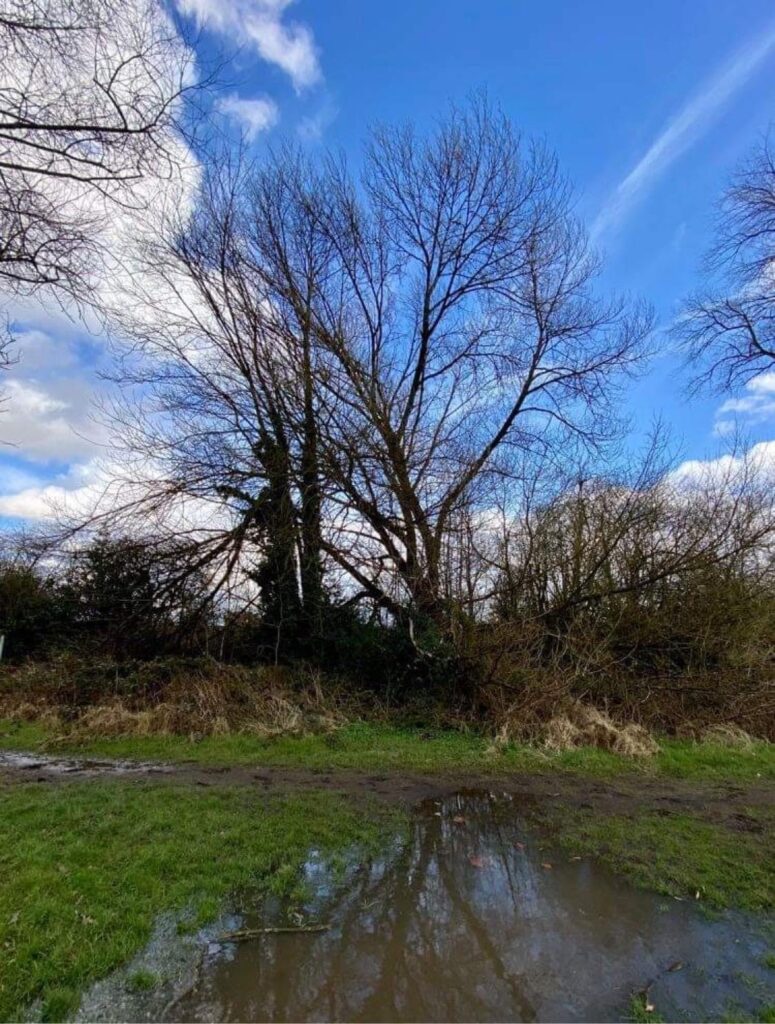Rare Native Black Poplar – Populus Nigra Betulifolia

Along the boundary of Ryebank Fields and the Longford Park Conservation area stands a row of tall and impressive Black Poplar trees. There are many hybrid varieties of Black Poplar but a native Black Poplar is a rare find. Black Poplars are notoriously difficult to identify from field study alone so, in October 2020, we had ten of the trees DNA tested by the Forestry Commission. These trees were identified as hybrids. They have significant heritage value as it is believed they were planted by famous Manchester industrialist and philanthropist John Ryland’s third wife, Enriqueta. (Please see our separate article ‘Enriqueta’s Trees.’)
There was one tree that we were unable to get a leaf sample from for DNA testing in October 2020. On advice from Forest Research, we took cuttings from this tree which we then propagated indoors, and once leaves had formed, in early 2021, we sent a sample off for testing. We got the results in April 2021 and were very excited to have our tree confirmed to be a native Black Poplar, Populus Nigra subsp. Betulifolia – otherwise known as the ‘Manchester’ Poplar – one of the UK’s rarest trees!
Our hopes had been raised by red catkins indicative of a male tree (the Manchester Poplar is a male clone); elongated leaf tips and hairy leaf petioles (all good signs), but we still needed DNA testing to be sure.

The tree sits quite deep in the hedgerow and is flanked by vegetation on both sides making it difficult to pick out but it is a truly stunning specimen with long low-sweeping boughs that extend outwards and hang poised just inches from the ground.
Black Poplars were mass planted in Manchester from the 19th century onwards due to their unique ability to resist the smoky polluted air of the city and thus they acquired the name of Manchester Poplars. At this time Manchester was known as Cottonopolis, with its multitudinous mills casting their dust and grime over an ever industrialising landscape. Manchester Poplars were planted to combat pollution and were heralded as the climate solution of the times.
Sadly Manchester Poplars are now a rare sight as they were hit by a virulent airborne disease known as “poplar scab” in 2000, all but wiping them out in Manchester. It is difficult to produce viable seedlings and so this tree, which is integral to our city’s heritage, is in imminent danger of dying out. Other remaining specimens can be found in St John’s Gardens, Alexandra Park and Crumpsall Park but they are few are far between.
Our Manchester Poplar is of significant conservation interest, and MMU’s development proposals place it at considerable risk. Longford Park is a conservation area which should afford the tree some protection, but its root system spreads well into Ryebank Fields, and its canopy and low sweeping branches overhang, making it extremely vulnerable.
Manchester City Council has refused to assess any of the trees on Ryebank Fields for Tree Preservation Orders and it is well documented that, even where planning conditions exist, trees are often lost as ‘collateral damage’.
Black Poplars promote biodiversity as they provide food for the caterpillars of many moths, the catkins provide an early source of pollen and nectar for bees and other insects, and the seeds are eaten by birds.
Our Manchester Poplar must be protected, not only for its intrinsic value, but because its presence will encourage and support a host of other wildlife to thrive.
This was a joint venture with the Friends of Longford Park, who generously sponsored the DNA test for this tree.
By Julie Ryan
You can find out more about the Manchester Poplar here: